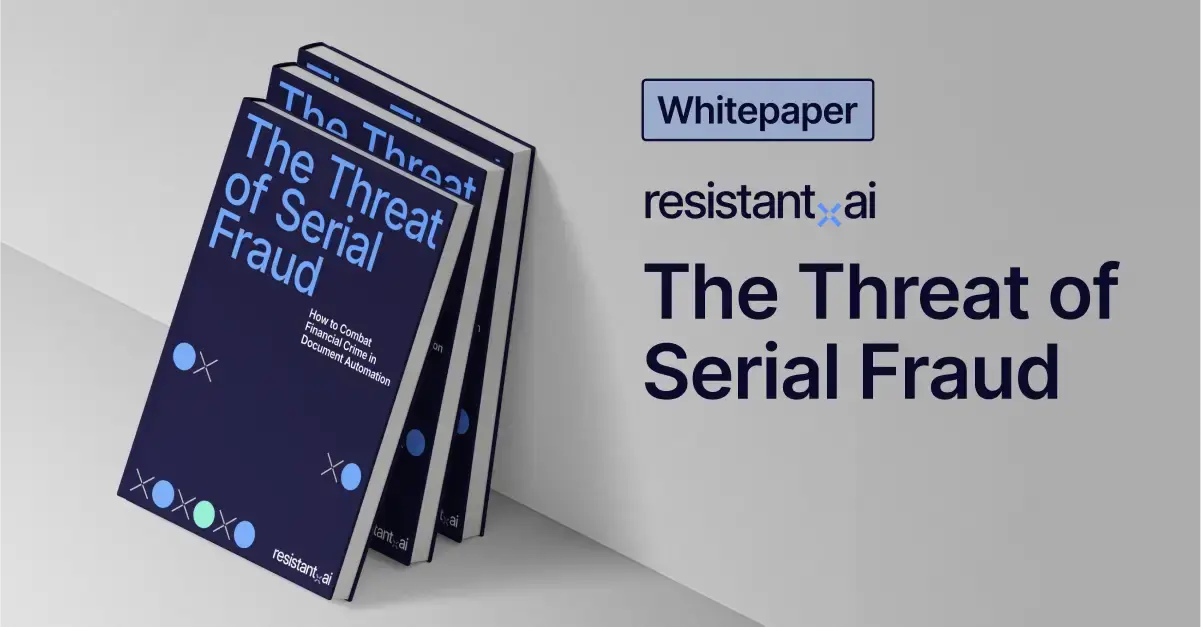
You might be interested in










Automated document processing is a game-changer for any organization across the globe.
When done right with AI document processing services, a firm’s ROI can go up 200% in labor savings in the first year. From eradicating human errors to accelerating workflows, the advantages of automated document processing are endless.
Yet, automated document processing can be risky for certain industries due to document fraud. Depending on the purpose of these documents, the risks of AI document processing vary. For lenders, the purpose of these documents is to establish trust with incoming applicants. On the other hand, a charity digitizing years of internal data to have an accurate and comprehensive database has a completely different intent.
Here's a snippet of one of the risks identified during our latest document fraud webinar where Nico, our fraud solutions expert, dives into how some forms of document fraud can bypass automated document processing processes:
Hence, every company should focus on tailoring their document processing solutions to eliminate potential risks.
Document processing is a procedure that converts physical and analog data into a digitized version that can be stored for future reference. For many firms, document processing is simply an efficient and effective method to organize internal record-keeping.
There are three main AI document processing methods within the market. Based on the organization’s requirements, document processing services differ from one to the other. These document digitization solutions are commonly segregated into:
Depending on the corporation’s requirements, choosing the right document processing with AI is just the first step. In reality, it is crucial for companies to also add in a document fraud detection software to safeguard their assets.
OCR is one of the document digitization solutions that converts handwritten or scanned texts within images or documents into machine readable data. Commonly known as ocr scanning or ocr text recognition, it is especially useful for digitizing physical documents to help companies create searchable, and sorted data for online archives.
RPA is a robotic software that works on predefined rule based business procedures which is particularly useful for repetitive tasks including data entry and data processing. It is important to note that RPA should only be used in procedures that do not require decision making. Unlike IDP, RPA does not use machine learning or any AI algorithms and works on a given set of rules to automate data extraction from documents.
IDP is a form of AI document processing that incorporates the use of OCR to capture, extract, and process data in business documents for any industry–no matter the type of departmental process. It works by using machine learning to sort extracted data into different categories, just like how the human mind works. Simply put, a good IDP software interprets data from structured and unstructured documents to help businesses automate their processes.
Even though the document processing with AI drives efficiency and effectiveness, it also brings a range of issues to the table.
Despite the influx of companies driving the automation of document processing with AI, many still struggle with the risks it carries. Here are some of the most common ones associated with automated document processing:
No matter how effective automated document processing is, it is still prone to document fraud–since this is only data extraction–not document authenticity verification. With the rise of document tampering, where one in five digital financial documents show signs of fraud that are invisible to the naked eye, using just a document automation software is no longer enough. Instead, firms need to incorporate fraud detection tools into AI document processing to safeguard their interests.
Automated document processing only works as well as the quality of the input data. Low quality data can hurt the overall output.
These low quality images defeat the purpose of digitizing documents as additional time is needed to check each document to fully eliminate all inaccuracies, lowering overall process efficiency.
Since LLMs came into the picture for IDP, it has came along with a slew of other issues. From probable data privacy breaches to data poisoning, LLMs is still not the most stable tool for most organizations. Due to its reliance on initial trainings through large datasets of texts and codes, LLMs are also prone to biased decisions if discrimination exists in legacy data. In addition, LLMs are known to falsify data to provide inaccurate information which can be detrimental to businesses especially in the form of documents. Lastly, fraudsters have been known to use LLMs to create fake documents such as phone scripts to steal personally identifiable information, phishing emails, and even fake profile or job listings.
Among the risks involved, document fraud is of utmost importance to any company that relies heavily on document authenticity verification. Hence, it is crucial for businesses to set preventative measures in place to detect document fraud during the document processing phase.
Document fraud, aka document tampering, is the modification or forgery of documents—either from scratch or from genuine copies. With template farms garnering over 1.7M monthly visits, modifying or creating fraudulent documents is no longer challenging.
Since document processing is automated to save cost and time, the first step for any businesses is to add a document verification software that specializes in AI fraud prevention. This ensures that the purpose of saving time and money remains throughout the phases of document processing and verification. Hence, for businesses, knowing what fraud prevention techniques to take is paramount.
Document fraud has many faces, sometimes with a single template or several documents simultaneously. A good example is Doc Juicer—the largest template farm on record. Given the vast extent of forged documents and fake templates available, here are some of the most common examples of document fraud:
Due to the extensive nature of document fraud, it is becoming increasingly difficult to verify documents–which is why we have compiled a comprehensive list for organizations to take note of. For AI document processing companies, the onset of fake documents pdf foreshadows weakened fraud security. Instead of mitigating hefty losses from fraudulent documents, firms should strive to eradicate fraud in the very beginning–which is why document fraud prevention is essential.
Document fraud prevention refers to the measures taken to stop fraud from infiltrating the firm. Depending on the company, it is usually a multi-faceted approach that aims to strengthen fraud security.
As the saying goes, “Prevention is better than cure.”
For most businesses, this approach usually involves spotting fake documents through an AI fraud detection system or in-house fraud detection specialist. However, the best fraud detection software goes one step further by connecting the dots to identify serial fraud perpetrators behind the scenes.
Using AI to read documents is just the beginning for document processing services–the next step should be document forgery detection.
In document processing, there are two broad ways to identify document fraud–either manually or AI fraud detection. To help you further, here are the main ways on how to catch document fraud:
For organizations that already automate document processing, using manual reviews defeats the purpose of efficiency since every document has to be verified by a human, again. Therefore, firms should consider incorporating document intelligence with fraud prevention services such as a fake document checker helps to catch sophisticated fraud.
However, for firms that have yet to automate document processing, manual reviews would be a natural choice. Yet, it is not the wisest–especially since one in five digital documents shows signs of fraud invisible to the naked eye, not to mention the additional costs of labor and resources. This includes serial fraud—a newer era of fraud that is impossible to detect with the human eye.
The best way to catch fraud is through the combination of an AI fraud detector and document intelligence. When done correctly, a document fraud detection system acts as a precautionary and preventive measure to safeguard any company’s assets.
Since AI detects 30% more fraud than manual reviews, it can be an incredibly useful tool for fraud detection specialists, business owners, underwriters, and even analysts. Instead of letting people guess if a document is fraudulent, AI detection goes one step further to show you exactly where and when–in seconds.
In addition, firms can also go one step further by using a fraud risk assessment, KYC onboarding process or AML framework. These features needed vary from company to company, which is why adequate research is needed with a deeper understanding of the scale, extent, and possibilities of document fraud.
The easiest way to use AI for fraud detection is to add a document verification service in the document processing procedure. To save costs, the adopted software needs to be simple to use and easy to implement.
This usually works because an AI fraud detector uses machine learning models to sift through datasets, analyze metadata, and identify forgery or discrepancies. With the added value of detecting document fraud that the naked eye can’t see, a fraud detection software is an indispensable benefit for many organizations.
The best document fraud detection software depends on your company’s needs. Depending on the workflow that the firm is going for–the chosen solution is heavily reliant on the purpose of the documents, the type of documents, and regions involved.
For example, lenders prioritize document authenticity–hence, a document fraud detection software that adds a layer of security during the document processing stage is best. This can range from rejecting poor quality files to classifying current documents–to ensure that businesses can err on the side of caution to weed out bad actors in the beginning.
Document processing is a taxing and tedious process that needs to be digitized. Yet, many companies fail to realize that document processing without an AI fraud detector is a company’s biggest kryptonite.
For safety and security to be the cornerstone of any document processing procedure, the best approach is to kill two birds with one stone.
Start by adding a document forensic software to your document processing services to mitigate fraud risks while automating the process.


